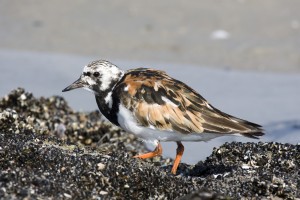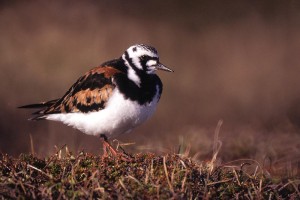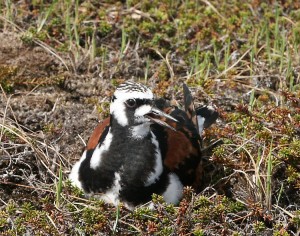
This bird was on a beach, as they often are, and it was turning over pebbles as its name, turnstone, would suggest it does. Have you watched turnstones tossing small pebbles aside with their beaks? I recommend it.

They really do throw the pebbles around. And I guess they are looking hard for small crustacea as they scurry away from under the tossed stones. I couldn’t really see what these turnstones, for there was a small flock of them, were doing so I looked at how beautiful they were instead.
Now I’ve seen plenty of turnstones, and thinking about it a little, I’ve seen them in plenty of places which have included rocky and sandy shores around the UK coast, but I’ve not really looked at them and watched them very much. I certainly haven’t seen turnstones feeding on a human corpse as was reported in a celebrated note in British Birds many years ago (was it by the late, great Bernard King – or have I misremembered that?).

And yet, and yet, it is a peachy little bird. Certainly the ones tossing stones on this beach were gorgeous. Still in its tortoiseshell breeding plumage the thing that struck me the most was the beauty of their heads. Turnstones have white tops to their heads with black streaks in the white. At the moment my hair is brown with some white streaks in the brown, but give it time and I will probably resemble a turnstone more closely.
Look at their black patterned faces. They are very striking – aren’t they? And it seemed to me at a quick look that they were all different. Can you recognise turnstones by their faces a bit like Bewick’s swans, I wonder?
I don’t know very much about turnstones but I enjoyed watching the tossers on the beach.
[registration_form]
For a moment then Mark, I thought from the title that it was another update in the wuthering moors saga where we learn that NE and DEFRA have flushed more tax payers money down the toilet on appeasing their grouse farming friends.
Indeed the turnstone is a much overlooked stunner that we probablly take for granted. Imagine the commotion it would cause if it was a scarce breeder from Asia and an adult in breeding plumage turned up in the UK one autumn?
I often think the woodpigeon would fit into that category
Ah yes, one of my favourites and – not that I keep lists – one of my few ‘four-continent ticks’, having seen them in Europe, North America, Africa and Asia.
Also the answer to one of my favourite clues in a Times crossword many years ago: bird looks for Newcastle (9).
(Turns to NE, for any reader not familiar with cryptic clues).
Absolutely to the point Mark. We should never forget to look at birds being themselves and I love turnstones not least because they do what they do. Sanderlings the same, they are lovely and lovely to watch. And, er, linnets.
Alan – not linnets
“Can you recognise turnstones by their faces a bit like Bewick’s swans, I wonder?”
They are certainly variable and I believe work has been done that showed that variations in plumage markings in turnstone, especially the black bib, was linked to dominance /breeding success.